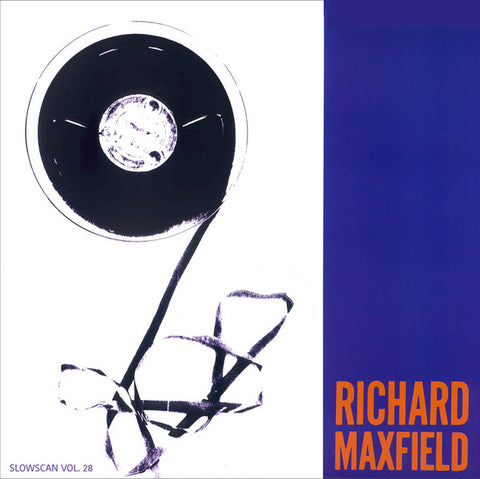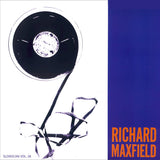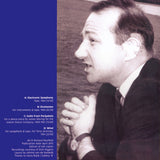MAXFIELD, RICHARD - s/t (Slowscan Vol. 28)
Spare sealed copy of 2015 release, not to be confused with the 2014 release of the same name. Edition of 250 copies (80 of which were reportedly "lost in transit"..)
"This double LP introduces an invaluable selection of early electronic Richard Maxfield pieces featuring four distinct works composed between 1959-1964 and previously unpublished (Dromenom, Electronic Symphony, Suite from Peripateia, and Wind). While Maxfield did not exclusively compose electronic music, winning the Gershwin Prize in 1959 for his orchestral work Five Movements, it was within the genre of electroacoustic composition that Maxfields contribution had the most influence. He was one of the first American composers to create works for acoustic instruments with tape accompaniment, and his technique of creating works containing frequencies outside of the range of normal human hearing (below 20Hz or above 20000Hz) that are modulated to produce sounds has since become a notable characteristic of electroacoustic composition.\r\n
The LP is printed in a edition of 250 copies, includes Electronic Symphony (for tape, 1964), Dromenon (Ballet for tape and live instruments, as performed at Judson Memorial Church, Washington Square, New York City. Opening Night, 1964), Suite from Peripateia (for a dance piece by James Waring for the Judson Dance Company, 1950-1961), and Wind (for saxophone & tape, 1961). Recordings courtesy of Dick Higgins._¢‚Ǩ¬ù - Slowscan.
\r\n_¢‚Ǩ_ì[La Monte] Young was Maxfields teaching assistant [at Berkeley] and became one of the principal performers of Maxfields work. Through working closely with Maxfield in 1960 and 61, Young has observed that, "much of Maxfields tape music was created through a technique which included pre-recording and electronically manipulating sound sources of various duration, then cutting lengths of tape containing these sounds and putting them in large glass mixing bowls. He would randomly draw pieces of tape from the bowls and splice them together placing blank tape of various durations between each of the pre-recorded sounds. What was interesting was that although this was theoretically a Cageian aleatorical approach, Maxfield reserved the right to put back any sounds he did not like and continue to draw new sounds until he found the piece sounding in a way that inspired him. Sometimes several of these reels of spliced together sounds and silences, called inter-masters, were played simultaneously on separate tape decks in concert or mixed together to form a new stereo or mono original master. His compositions were extremely well-crafted, using a sparse, static form and exhibiting a wry humor and unusual sophistication." Young points out that Maxfield was the first American composer to build his own equipment for the purpose of generating electronic tape music and was possibly the first American to compose purely electronic music as distinct from "musique concrete" composed of non-electronic pre-recorded sounds._Ç \r\n
\r\nThe tape elements of Maxfields compositions, which included both concrete and electronically generated materials, were all produced in his own studio in New York. His equipment was rudimentary: several kit-built, sine-square wave generators, two tape recorders, a homemade mixer and a homemade turntable, microphones, a "Dynamic Spacexpander" (a kind of reverberation device), possibly some filters, and inexpensive switches, amplifiers and speakers. In 1962 Maxfield said about his work, speaking of himself in the third person, "Much of his music has as its source material recorded sounds of the instrumentalists who in performance improvise with electronic tape (which is playing their earlier recorded sounds, now distorted by electronic manipulation).... He is generally quite selective about his raw material and its alteration, but quite free with regard to placement (organization) of the finished product and the improvisation going on simultaneously."_Ç \r\n
\r\nMaxfield performed his works in New York in the late 50s and early 60s at both uptown halls and downtown lofts and performance spaces. In what was historically New Yorks first loft concert series, directed by La_Ç Monte Young at Yoko Onos studio in 1960-61, Young presented two evenings of the work of Maxfield as well as concerts of the work of Jennings and other artists who were creating new and radical work at that time. David Tudor, Terry Riley, Terry Jennings, Dick Higgins and George Maciunas were some of the other artists with whom Maxfield worked. He was Musical Director of the James Waring Dance Company and his work was performed regularly in major concert series, at the Living Theatre, and for dances by Aileen Passloff and Paul Taylor._Ç \r\n
\r\nIn 1967 Maxfield left his tape music, scores and equipment in the care of Walter De Maria. He moved to San Francisco, where he taught at San Francisco State College in 1966 and 67. He moved to Los Angeles in 1968. In 1969 Richard took his own life._¢‚Ǩ¬ù - William Dawes.
-
Sale
- Regular price $62.00




